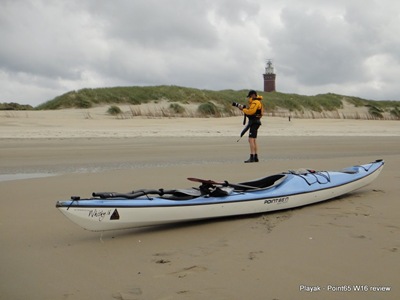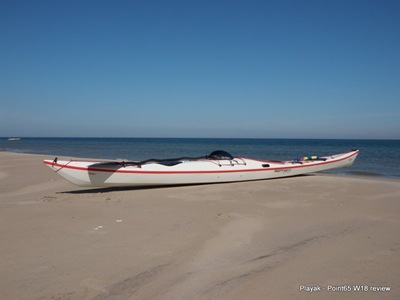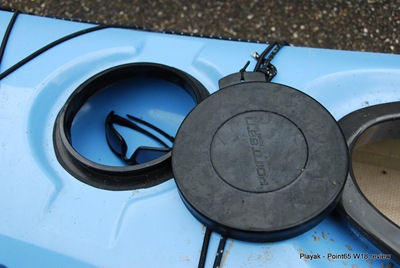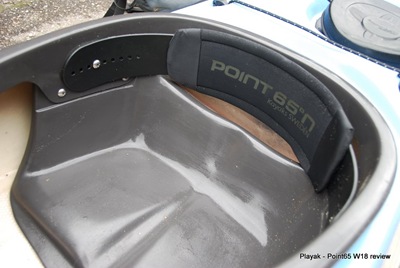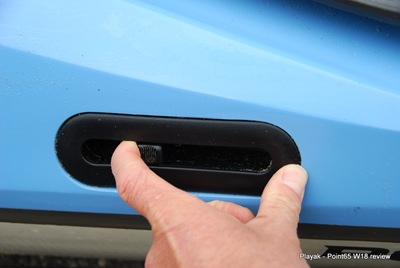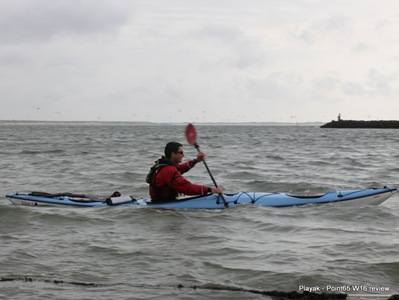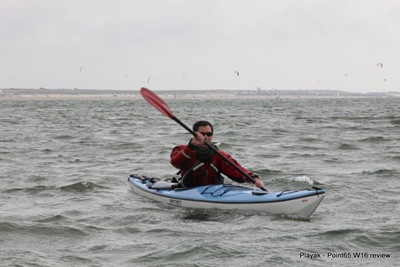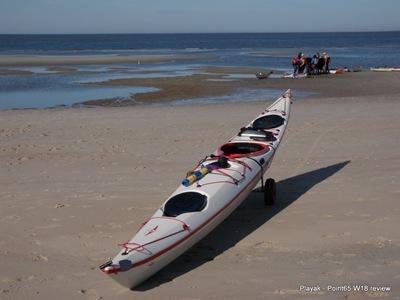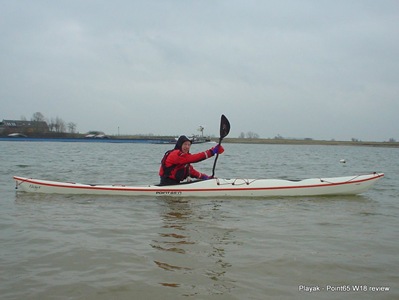[please login to make this ad block disappear]
Articles
Independent Playak Review: Point 65 Whisky 16 and 18
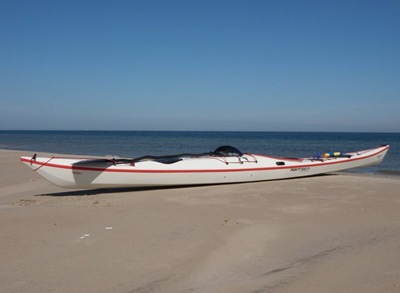 A long term test of the Point 65 Whisky 16 and Whisky 18 sea kayaks.
A long term test of the Point 65 Whisky 16 and Whisky 18 sea kayaks.
Introduction – Manufacturer’s design brief
Point 65 introduced the Whisky 16 sea kayak in 2008 and the Whisky 18 a year later. The designs were the result of a close cooperation between the Swedish kayak manufacturer and legendary British Kayak designer and sea kayak instructor Nigel Foster. With the design of the Whisky 16 Nigel wanted to create at a “quick-turning, relatively stable kayak to use for playing in rock-gardens, waves and surf”. The Whisky 18 is the bigger brother and shares many of the characteristics of the Whisky 16. Point 65 calls the Whisky 18 “a comfortable, easily maneuvered and stable craft that inspires confidence. It’s designed as a boat in which to develop kayaking skills and its generous loading capacity makes it the ideal craft for extended, self-contained expeditions. For the experienced paddler it is a spirited touring kayak. It also provides an excellent platform for instructing.”
The Whisky 18 was discontinued in the 2011, but because of the similarities and because some Whisky 18 kayaks are still available, this review describes both versions. On the photos, the Whisky 16 is the kayak with the blue deck; the Whisky 18 is the white kayak with the red line.
Test conditions
Playak tested the Whisky 18 from summer 2009 - summer 2010, and the Whisky 16 from fall 2010 – early summer 2011. Both kayaks were intensively paddled on the Dutch channels, rivers, lakes, the Wadden Sea and the North Sea. Thanks to the long testing period a wide variation of conditions is covered: from flat water with no wind, to sea and surf and winds up to 5-6 Bft, waves up to 1.5 meter, daytrips and camping-trips, loaded and unloaded. The Whisky 18 was also used for instructing and coaching sea kayakers at a 3* sea course and assessments.
The tester is a licensed sea kayak instructor and weighs 75 kg at 1.82 m.
Design, Construction and Finish
Both Whisky kayaks look refreshingly different compared to most British design sea kayaks. The hull has a very flat design, a hard chine along the waterline, plenty of rocker, a snub nose and carries a lot of volume in both bow and stern. This design gives the kayaks a compact, muscular look. The main difference between the Whiskies is the length: a 16-footer (4.89 m) and a 18-footer (5.49 m), width is the same at 22 inches (56 cm). The increased length and volume of the Whisky 18 is concentrated at the front – giving the Whisky 18 a very long front deck.
The deck lay-out matches the current sea kayak standard with 2 large oval hatches aft and front and a large round day hatch behind the cockpit. A real bonus is the extra 15 cm round hatch just in front of the cockpit. This little hatch opens to an under deck compartment and proved to be very handy for all the small items you need quick at hand (flares, sunglasses, sunscreen, camera and a candy bar).
While the storage capacity of the Whisky 16 is already more than sufficient for multiple day trips (thanks to the high volume in the bow this boat takes more luggage than most comparable 16-footers), the capacity of the Whisky 18 is simply overwhelming. This is the true bulk-carrier in the kayak breed! In addition to the gear for a week camping I loaded the Whisky 18 with a large professional DSLR-kit, 17” laptop, beamer and still there was plenty of room left.
Deck storage of split paddles, bilge pump and other kit is facilitated by smart positioned elastics and deck lines. The deck lines are not continuous around the fore and aft deck (they are interrupted along the large oval hatches), but on the critical spots there is a line present that offers good grip (in case of rescue). I would replace the short double loop at the toggles by a (longer) single line to prevent squeezing fingers between kayak and deck. A nice proof of the care for detail are the reflective deck lines on the Whiskies .
The large keyhole cockpit guarantees easy entry and exit, while the padded thigh braces, in combination with the contour of the deck and the shape of the seat, offer excellent boat contact. The cockpit fits a surprising wide range of paddlers. It is roomy enough for large paddlers with big feet. But more slender paddlers don’t feel lost either. It’s the proof of an ergonomically brilliant design that without any modification (no need to add foam-blocks) the boat also offers smaller paddlers a snug fit. The shape of the seat and the support of the backrest seriously contribute to this. The backrest is a (padded) stiff plastic band. A simple but functional design that offers good lumbar support. It takes some effort (and tools are needed) to adjust it, because you need to unbolt the backrest form each side of the seat and using the pre drilled holes to position it. But once in place, it stays in place. Unlike many other designs it doesn’t fold back when you slide in the cockpit during a wet re-entry. The footrests are easy to adjust (also on the water, sitting in the kayak) and lock firmly in position.
The Whisky kayaks come standard fitted with a retractable skeg, and are prepared for a (optional) rudder control system (not tested by Playak). The skeg operates on a cable-based system. The slider is mounted in a recessed control unit. This unit is nicely flush with the deck and doesn’t interfere with paddling. However the recessed design makes it a bit tricky to operate the skeg with gloves on in winter-conditions.
The Point 65 Whisky kayaks are built in China. The Whisky18 Playak tested, was one of the first samples produced on Chinese production line and in this order not representative for the current production quality. The finish of the (2010) Whisky 16 is good. The tested kayaks were in the standard version with a nice smooth vacuum bagged fiberglass lay-up with honeycombed core-matt for extra rigidity. The weight is a little on the heavy side, but the kayak is still comfortable to handle by one person and very rigid – the kayak withstood harsh testing conditions with ease and still looks as new. The hatches proved to be tight during the test period. Closing oval hatches demands a bit of extra accuracy, but when done so: all compartments stay bone-dry.
On the water – Performance
Regarding the design of the hull with the very the shallow arch and a fair amount of rocker it’s not strange that the Whiskies are stable like a brick and highly, highly maneuverable. Even without edging the boat, a couple of sweep strokes turn the kayak without any effort around. At speed the kayak responds direct to leaning and edging. With the solid feedback of the hard chine and the perfect boat-contact of the cockpit the kayak invites to experiment with edging and leaning. The kayaks easily hold an edge – without any limit. Extreme leaning, putting the kayaks on his side, sculling for support or doing a balance brace are highly facilitated by the freeboard that keeps the boat at 90 degrees. Thanks to the ergonomic cockpit design, the shape of the hull and the low back deck the kayak rolls easy with or without paddle.
The surprise is that the large whisky 18 is exactly as nimble as its smaller sibling. This makes the Whisky 18 a very unique kayak: I can’t remember any 18 foot kayak that is so extremely agile. These maneuverability and agility indeed make the whiskies a good teaching boat for instructors and a perfect learning boat for students as well.
Too much maneuverability can hinder keeping a course, but that is not problematic with the Whiskies. Both kayaks do track well. There is a slight difference between the Whisky 18 and the Whisky 16. The longer waterline of the Whisky 18 does make it track a bit stronger. It’s no big difference but in the Whisky 16 you might be just a bit earlier tempted to drop the skeg a cm or so to keep it running a straight line.
More exact to measure is the speed of the two kayaks. Again it’s not a huge difference but it’s noticeable. The Whisky 16 accelerates a bit faster than the 18, while the Whisky 18 holds (on flat water) a higher cruising speed than the 16. Just for an indication: Paddling a “decent pace” on flat water I could hold an average speed in the Whisky 16 of about 8 km/h, and in the Whisky 18 of about 9 km/h. Don’t compare these figures with other boats – you might be (or not? ;-) a stronger paddler than I am. The Whisky kayaks are surely not the fastest kayaks in their class. There are boats in the same length range in which you’ll be going half a knot faster. But unless you are a racer, or you are focused on covering long distances on flat water, consider if this is an issue. The Whisky kayaks are fast enough to keep up with the rest of the group, in practice you paddle mostly far below the hull speed of the kayak and then the differences are minimal.
Due to their high volume the Whisky kayaks can catch quit some wind. In windy conditions on flat water comes the skeg of the Whisky 16 in play: by dropping the skeg the kayak can be trimmed precisely to compensate the tendency to weathercock. This story would probably the same for the Whisky 18, but here I struggled a bit. With a 75 kg paddler and no extra load in the kayak the bow of the Whisky 18 becomes very light, high on the water, causing the kayak to leecock, which can’t be compensated by lowering the skeg. The solution in this case is to trim the waterline kayak by putting (serious) extra weight in the front compartment. The performance of the Whisky 18 will probably be more balanced with a heavier paddler (90 kg plus?). Anyway: the Whisky 18 is clearly not a “daytrip-kayak” for the lighter paddler (why should it? – there is a Whisky 16).
Mostly (but not always) wind comes with waves. In this situation the tendency of the kayaks for weathercocking is less distinct. When the side wind catches the bow at the moment that it’s lifted by the wave, the kayak can leecook for a moment, but due to the agility of the kayaks this is easily corrected by a paddle stroke. On large open choppy waters side winds from 4-5 Bft proved to be no issue, as a matter of fact I hardly used the skeg in these conditions. In short steep waves, typically for moderate “wind against tide conditions” the bow of the Whisky tends to slam at the wave, at the cost of some speed.
The rougher it gets, the better the Whisky comes in its element. It’s a solid boat that gives a lot of confidence. The volume in the bow helps the kayak to ride over the chop and prevents it from dipping down deep when running down the wave. The flat planing hull gives a perfect ride down the waves. The rocker and the hard chine let the kayak carve down the wave beautifully. Sitting in the snug cockpit of the Whisky you easily forget that you are paddling a sea kayak: it handles almost like a WW-playboat!
Conclusion
The Point 65 Whisky 16 and 18 proved to be very versatile kayaks. The Whisky is a combination of an agile A to B tourer and a playboat for the sea. As a tourer it’s a kayak that gives confidence: it’s stable and comfortable, turns easily and packs a lot of load. As a playboat it’s a kayak that challenges you to push your limits: it’s the surfing machine with awesome performance in rough water: the playful kayak for hunting out waves. As a tourer it’s good. As a playboat it excels. The combination of both characteristics is the essence of the Whisky design. In the long term test I really learned to appreciate these characteristics of the Whisky. It’s a luxury to be able to choose between multiple sea kayaks – the Whisky 16 has become a favorite. I really loved to pick it out of the boathouse and often let faster tourers in the rack, just because the Whisky is such a fun kayak to paddle.
The similarities between the Whisky 16 and 18 are obvious. It’s interesting that the package is available in 2 sizes. I ( a paddler of “average size”, 75 kg, 1.82 m) found the Whisky the most balanced kayak. Weight, size and power of the paddler are determining factors. The Whisky 16 also fits a larger, heavier, more athletic person. Handling might be a bit different when you are bigger. Really big guys may be better of the Whisky 18. Just try it. As always: try before you buy!
For Playak,
Hans Heupink
A little rolling sequence:


